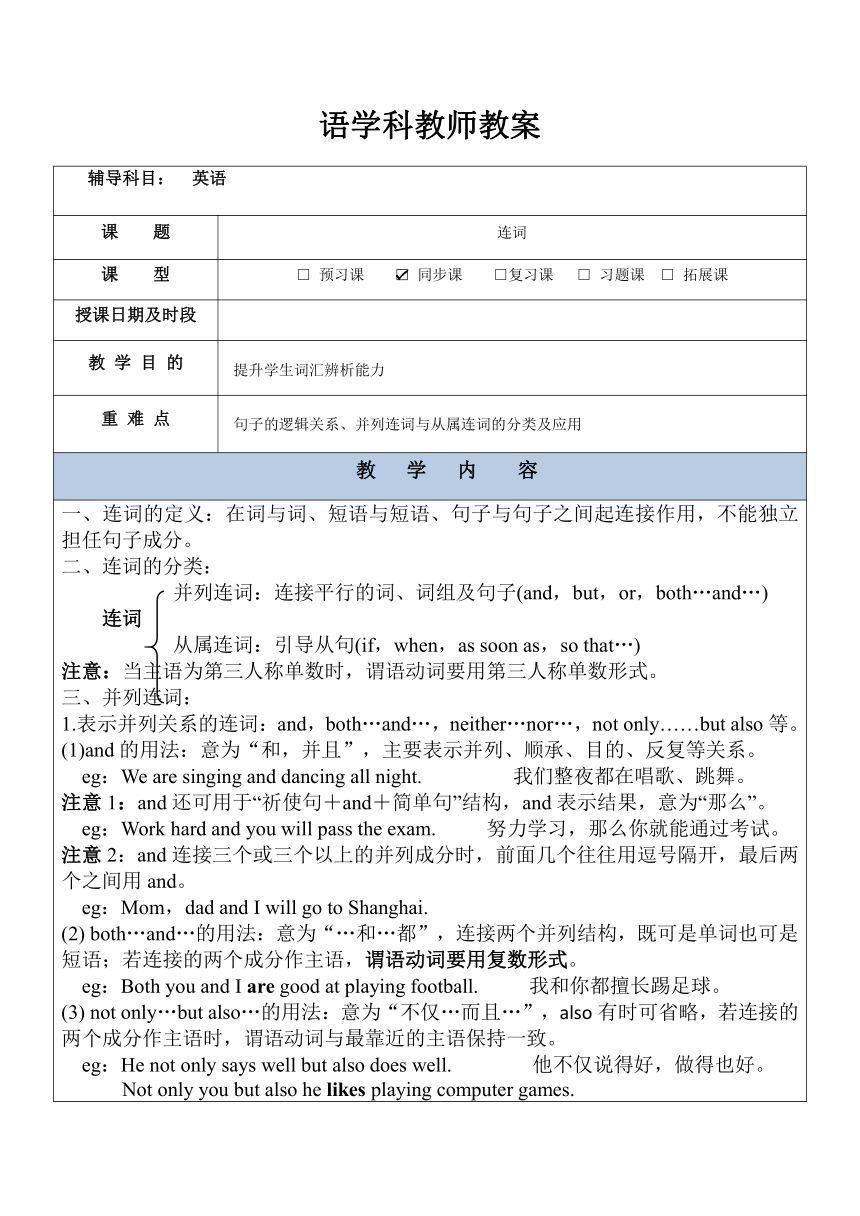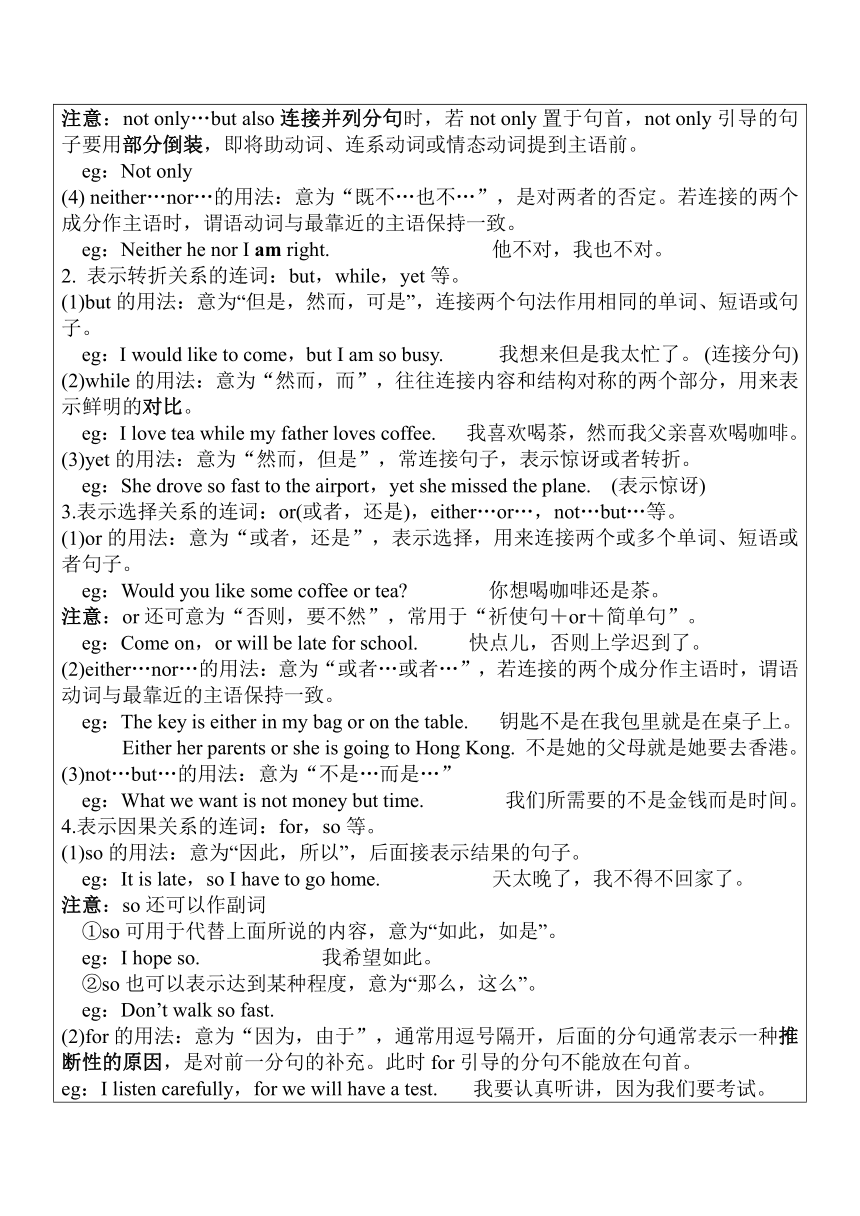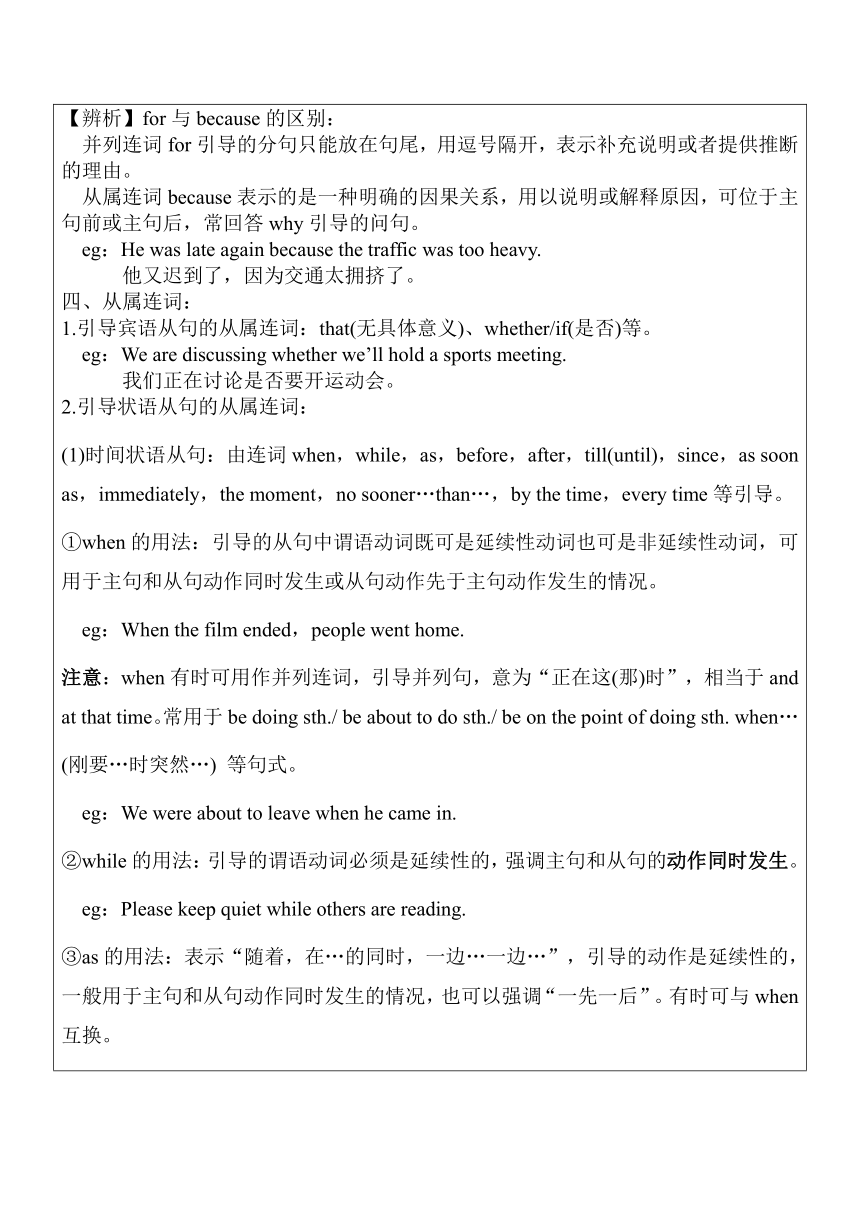2022届高三英语二轮复习连词专题教案(表格式)
文档属性
| 名称 | 2022届高三英语二轮复习连词专题教案(表格式) |  | |
| 格式 | docx | ||
| 文件大小 | 28.4KB | ||
| 资源类型 | 教案 | ||
| 版本资源 | 通用版 | ||
| 科目 | 英语 | ||
| 更新时间 | 2022-04-15 22:31:17 | ||
图片预览



文档简介
英语学科教师教案
辅导科目: 英语
课 题 连词
课 型 □ 预习课 同步课 □复习课 □ 习题课 □ 拓展课
授课日期及时段
教 学 目 的 提升学生词汇辨析能力
重 难 点 句子的逻辑关系、并列连词与从属连词的分类及应用
教 学 内 容
一、连词的定义:在词与词、短语与短语、句子与句子之间起连接作用,不能独立担任句子成分。 二、连词的分类: 并列连词:连接平行的词、词组及句子(and,but,or,both…and…) 连词 从属连词:引导从句(if,when,as soon as,so that…) 注意:当主语为第三人称单数时,谓语动词要用第三人称单数形式。 三、并列连词: 1.表示并列关系的连词:and,both…and…,neither…nor…,not only……but also等。 (1)and的用法:意为“和,并且”,主要表示并列、顺承、目的、反复等关系。 eg:We are singing and dancing all night. 我们整夜都在唱歌、跳舞。 注意1:and还可用于“祈使句+and+简单句”结构,and表示结果,意为“那么”。 eg:Work hard and you will pass the exam. 努力学习,那么你就能通过考试。 注意2:and连接三个或三个以上的并列成分时,前面几个往往用逗号隔开,最后两个之间用and。 eg:Mom,dad and I will go to Shanghai. (2) both…and…的用法:意为“…和…都”,连接两个并列结构,既可是单词也可是短语;若连接的两个成分作主语,谓语动词要用复数形式。 eg:Both you and I are good at playing football. 我和你都擅长踢足球。 (3) not only…but also…的用法:意为“不仅…而且…”,also有时可省略,若连接的两个成分作主语时,谓语动词与最靠近的主语保持一致。 eg:He not only says well but also does well. 他不仅说得好,做得也好。 Not only you but also he likes playing computer games. 注意:not only…but also连接并列分句时,若not only置于句首,not only引导的句子要用部分倒装,即将助动词、连系动词或情态动词提到主语前。 eg:Not only (4) neither…nor…的用法:意为“既不…也不…”,是对两者的否定。若连接的两个成分作主语时,谓语动词与最靠近的主语保持一致。 eg:Neither he nor I am right. 他不对,我也不对。 2. 表示转折关系的连词:but,while,yet等。 (1)but的用法:意为“但是,然而,可是”,连接两个句法作用相同的单词、短语或句子。 eg:I would like to come,but I am so busy. 我想来但是我太忙了。 (连接分句) (2)while的用法:意为“然而,而”,往往连接内容和结构对称的两个部分,用来表示鲜明的对比。 eg:I love tea while my father loves coffee. 我喜欢喝茶,然而我父亲喜欢喝咖啡。 (3)yet的用法:意为“然而,但是”,常连接句子,表示惊讶或者转折。 eg:She drove so fast to the airport,yet she missed the plane. (表示惊讶) 3.表示选择关系的连词:or(或者,还是),either…or…,not…but…等。 (1)or的用法:意为“或者,还是”,表示选择,用来连接两个或多个单词、短语或者句子。 eg:Would you like some coffee or tea 你想喝咖啡还是茶。 注意:or还可意为“否则,要不然”,常用于“祈使句+or+简单句”。 eg:Come on,or will be late for school. 快点儿,否则上学迟到了。 (2)either…nor…的用法:意为“或者…或者…”,若连接的两个成分作主语时,谓语动词与最靠近的主语保持一致。 eg:The key is either in my bag or on the table. 钥匙不是在我包里就是在桌子上。 Either her parents or she is going to Hong Kong. 不是她的父母就是她要去香港。 (3)not…but…的用法:意为“不是…而是…” eg:What we want is not money but time. 我们所需要的不是金钱而是时间。 4.表示因果关系的连词:for,so等。 (1)so的用法:意为“因此,所以”,后面接表示结果的句子。 eg:It is late,so I have to go home. 天太晚了,我不得不回家了。 注意:so还可以作副词 ①so可用于代替上面所说的内容,意为“如此,如是”。 eg:I hope so. 我希望如此。 ②so也可以表示达到某种程度,意为“那么,这么”。 eg:Don’t walk so fast. (2)for的用法:意为“因为,由于”,通常用逗号隔开,后面的分句通常表示一种推断性的原因,是对前一分句的补充。此时for引导的分句不能放在句首。 eg:I listen carefully,for we will have a test. 我要认真听讲,因为我们要考试。 【辨析】for与because的区别: 并列连词for引导的分句只能放在句尾,用逗号隔开,表示补充说明或者提供推断的理由。 从属连词because表示的是一种明确的因果关系,用以说明或解释原因,可位于主句前或主句后,常回答why引导的问句。 eg:He was late again because the traffic was too heavy. 他又迟到了,因为交通太拥挤了。 四、从属连词: 1.引导宾语从句的从属连词:that(无具体意义)、whether/if(是否)等。 eg:We are discussing whether we’ll hold a sports meeting. 我们正在讨论是否要开运动会。 2.引导状语从句的从属连词: (1)时间状语从句:由连词when,while,as,before,after,till(until),since,as soon as,immediately,the moment,no sooner…than…,by the time,every time等引导。 ①when的用法:引导的从句中谓语动词既可是延续性动词也可是非延续性动词,可用于主句和从句动作同时发生或从句动作先于主句动作发生的情况。 eg:When the film ended,people went home. 注意:when有时可用作并列连词,引导并列句,意为“正在这(那)时”,相当于and at that time。常用于be doing sth./ be about to do sth./ be on the point of doing sth. when… (刚要…时突然…) 等句式。 eg:We were about to leave when he came in. ②while的用法:引导的谓语动词必须是延续性的,强调主句和从句的动作同时发生。 eg:Please keep quiet while others are reading. ③as的用法:表示“随着,在…的同时,一边…一边…”,引导的动作是延续性的,一般用于主句和从句动作同时发生的情况,也可以强调“一先一后”。有时可与when互换。 eg:We always sing as we walk. As we were going out,it began to snow. ④表示“在……之前/之后”:before,after eg:You can go home before he finishes his work. You can go home after he finishes his work. ⑤表示“一……就”:as soon as,no sooner…than,hardly…when,once,immediately, directly,instantly,the moment,the instant,the second eg:I had no sooner reached home than it began to rain. 我一到家天就下起雨来。 No sooner had I reached home than it began to rain. 注意:no sooner与hardly引导的句子中谓语动词要用过去完成时(had done),且若no sooner与hardly位于句首时,此时要用部分倒装;than与when引导的从句中谓语动词常用一般过去时。 (2)条件状语从句:if,unless(=if not,除非),as/so long as,in case(万一)等。 eg:In case I forget,please remind me about it. If you work hard,you will make a great progress. 注意:在时间、条件状语从句中,有“主将从现”原则,即从句的谓语动词的时态常用一般现在时代替一般将来时;用现在完成时代替将来完成时。 (3)地点状语从句:where,wherever,everywhere,anywhere等。 eg:Where there is water,there is life. 哪里有水,哪里就有生命。 (4)原因状语从句:because,as,since(既然),seeing (that),now (that),considering (that)等。 eg:I do not want to go because I am tired of any party. 注意:for与because的区别: 并列连词for引出的分句只能放在句尾,前面用逗号隔开,表示补充说明或者提供推断的理由。 从属连词because表示的是一种明确的因果关系,解释原因,可位于主句前也可位于主句后,常用来回答why引导的问句。 (5)目的状语从句:so that,in order that,in case (以防),for fear (以免)等。 eg:I shall write down your phone number so that I may not forget. (6)结果状语从句:so that,so…that,such…that等。 eg:It is such an interesting novel that all of us want to read it. It is so interesting a novel that all of us want to read it. 注意:such后接名词,so后接形容词。 (7)让步状语从句:though,although,even if,even though,while,however,whatever,whoever,whenever,wherever,no matter how等。 eg:I will not trust you although you have told me the truth. (8)比较状语从句:than,as…as…,not as/so…as,the same…as等。 eg:Mary is as old as my sister. 练习: 1. I have to study too much I don’t get enough sleep. A. but B. so C. or D. for 2. Anna her brother like listening to soft music. A. Both;and B. Neither;nor C. Either;or D.Not only;but also 3. —Can students go online during lessons —They can it is for that lesson. A. or B. so C. but D. if 4. —Hurry up!The bus is coming. —Wait a minute. Don’t cross the street the traffic lights are green. A. after B. until C. while D. since 5. —What’s your plan for the summer holidays —I’ll go to Beijing the school terms ends. A. in order that B. so that C. as soon as D. even though
辅导科目: 英语
课 题 连词
课 型 □ 预习课 同步课 □复习课 □ 习题课 □ 拓展课
授课日期及时段
教 学 目 的 提升学生词汇辨析能力
重 难 点 句子的逻辑关系、并列连词与从属连词的分类及应用
教 学 内 容
一、连词的定义:在词与词、短语与短语、句子与句子之间起连接作用,不能独立担任句子成分。 二、连词的分类: 并列连词:连接平行的词、词组及句子(and,but,or,both…and…) 连词 从属连词:引导从句(if,when,as soon as,so that…) 注意:当主语为第三人称单数时,谓语动词要用第三人称单数形式。 三、并列连词: 1.表示并列关系的连词:and,both…and…,neither…nor…,not only……but also等。 (1)and的用法:意为“和,并且”,主要表示并列、顺承、目的、反复等关系。 eg:We are singing and dancing all night. 我们整夜都在唱歌、跳舞。 注意1:and还可用于“祈使句+and+简单句”结构,and表示结果,意为“那么”。 eg:Work hard and you will pass the exam. 努力学习,那么你就能通过考试。 注意2:and连接三个或三个以上的并列成分时,前面几个往往用逗号隔开,最后两个之间用and。 eg:Mom,dad and I will go to Shanghai. (2) both…and…的用法:意为“…和…都”,连接两个并列结构,既可是单词也可是短语;若连接的两个成分作主语,谓语动词要用复数形式。 eg:Both you and I are good at playing football. 我和你都擅长踢足球。 (3) not only…but also…的用法:意为“不仅…而且…”,also有时可省略,若连接的两个成分作主语时,谓语动词与最靠近的主语保持一致。 eg:He not only says well but also does well. 他不仅说得好,做得也好。 Not only you but also he likes playing computer games. 注意:not only…but also连接并列分句时,若not only置于句首,not only引导的句子要用部分倒装,即将助动词、连系动词或情态动词提到主语前。 eg:Not only (4) neither…nor…的用法:意为“既不…也不…”,是对两者的否定。若连接的两个成分作主语时,谓语动词与最靠近的主语保持一致。 eg:Neither he nor I am right. 他不对,我也不对。 2. 表示转折关系的连词:but,while,yet等。 (1)but的用法:意为“但是,然而,可是”,连接两个句法作用相同的单词、短语或句子。 eg:I would like to come,but I am so busy. 我想来但是我太忙了。 (连接分句) (2)while的用法:意为“然而,而”,往往连接内容和结构对称的两个部分,用来表示鲜明的对比。 eg:I love tea while my father loves coffee. 我喜欢喝茶,然而我父亲喜欢喝咖啡。 (3)yet的用法:意为“然而,但是”,常连接句子,表示惊讶或者转折。 eg:She drove so fast to the airport,yet she missed the plane. (表示惊讶) 3.表示选择关系的连词:or(或者,还是),either…or…,not…but…等。 (1)or的用法:意为“或者,还是”,表示选择,用来连接两个或多个单词、短语或者句子。 eg:Would you like some coffee or tea 你想喝咖啡还是茶。 注意:or还可意为“否则,要不然”,常用于“祈使句+or+简单句”。 eg:Come on,or will be late for school. 快点儿,否则上学迟到了。 (2)either…nor…的用法:意为“或者…或者…”,若连接的两个成分作主语时,谓语动词与最靠近的主语保持一致。 eg:The key is either in my bag or on the table. 钥匙不是在我包里就是在桌子上。 Either her parents or she is going to Hong Kong. 不是她的父母就是她要去香港。 (3)not…but…的用法:意为“不是…而是…” eg:What we want is not money but time. 我们所需要的不是金钱而是时间。 4.表示因果关系的连词:for,so等。 (1)so的用法:意为“因此,所以”,后面接表示结果的句子。 eg:It is late,so I have to go home. 天太晚了,我不得不回家了。 注意:so还可以作副词 ①so可用于代替上面所说的内容,意为“如此,如是”。 eg:I hope so. 我希望如此。 ②so也可以表示达到某种程度,意为“那么,这么”。 eg:Don’t walk so fast. (2)for的用法:意为“因为,由于”,通常用逗号隔开,后面的分句通常表示一种推断性的原因,是对前一分句的补充。此时for引导的分句不能放在句首。 eg:I listen carefully,for we will have a test. 我要认真听讲,因为我们要考试。 【辨析】for与because的区别: 并列连词for引导的分句只能放在句尾,用逗号隔开,表示补充说明或者提供推断的理由。 从属连词because表示的是一种明确的因果关系,用以说明或解释原因,可位于主句前或主句后,常回答why引导的问句。 eg:He was late again because the traffic was too heavy. 他又迟到了,因为交通太拥挤了。 四、从属连词: 1.引导宾语从句的从属连词:that(无具体意义)、whether/if(是否)等。 eg:We are discussing whether we’ll hold a sports meeting. 我们正在讨论是否要开运动会。 2.引导状语从句的从属连词: (1)时间状语从句:由连词when,while,as,before,after,till(until),since,as soon as,immediately,the moment,no sooner…than…,by the time,every time等引导。 ①when的用法:引导的从句中谓语动词既可是延续性动词也可是非延续性动词,可用于主句和从句动作同时发生或从句动作先于主句动作发生的情况。 eg:When the film ended,people went home. 注意:when有时可用作并列连词,引导并列句,意为“正在这(那)时”,相当于and at that time。常用于be doing sth./ be about to do sth./ be on the point of doing sth. when… (刚要…时突然…) 等句式。 eg:We were about to leave when he came in. ②while的用法:引导的谓语动词必须是延续性的,强调主句和从句的动作同时发生。 eg:Please keep quiet while others are reading. ③as的用法:表示“随着,在…的同时,一边…一边…”,引导的动作是延续性的,一般用于主句和从句动作同时发生的情况,也可以强调“一先一后”。有时可与when互换。 eg:We always sing as we walk. As we were going out,it began to snow. ④表示“在……之前/之后”:before,after eg:You can go home before he finishes his work. You can go home after he finishes his work. ⑤表示“一……就”:as soon as,no sooner…than,hardly…when,once,immediately, directly,instantly,the moment,the instant,the second eg:I had no sooner reached home than it began to rain. 我一到家天就下起雨来。 No sooner had I reached home than it began to rain. 注意:no sooner与hardly引导的句子中谓语动词要用过去完成时(had done),且若no sooner与hardly位于句首时,此时要用部分倒装;than与when引导的从句中谓语动词常用一般过去时。 (2)条件状语从句:if,unless(=if not,除非),as/so long as,in case(万一)等。 eg:In case I forget,please remind me about it. If you work hard,you will make a great progress. 注意:在时间、条件状语从句中,有“主将从现”原则,即从句的谓语动词的时态常用一般现在时代替一般将来时;用现在完成时代替将来完成时。 (3)地点状语从句:where,wherever,everywhere,anywhere等。 eg:Where there is water,there is life. 哪里有水,哪里就有生命。 (4)原因状语从句:because,as,since(既然),seeing (that),now (that),considering (that)等。 eg:I do not want to go because I am tired of any party. 注意:for与because的区别: 并列连词for引出的分句只能放在句尾,前面用逗号隔开,表示补充说明或者提供推断的理由。 从属连词because表示的是一种明确的因果关系,解释原因,可位于主句前也可位于主句后,常用来回答why引导的问句。 (5)目的状语从句:so that,in order that,in case (以防),for fear (以免)等。 eg:I shall write down your phone number so that I may not forget. (6)结果状语从句:so that,so…that,such…that等。 eg:It is such an interesting novel that all of us want to read it. It is so interesting a novel that all of us want to read it. 注意:such后接名词,so后接形容词。 (7)让步状语从句:though,although,even if,even though,while,however,whatever,whoever,whenever,wherever,no matter how等。 eg:I will not trust you although you have told me the truth. (8)比较状语从句:than,as…as…,not as/so…as,the same…as等。 eg:Mary is as old as my sister. 练习: 1. I have to study too much I don’t get enough sleep. A. but B. so C. or D. for 2. Anna her brother like listening to soft music. A. Both;and B. Neither;nor C. Either;or D.Not only;but also 3. —Can students go online during lessons —They can it is for that lesson. A. or B. so C. but D. if 4. —Hurry up!The bus is coming. —Wait a minute. Don’t cross the street the traffic lights are green. A. after B. until C. while D. since 5. —What’s your plan for the summer holidays —I’ll go to Beijing the school terms ends. A. in order that B. so that C. as soon as D. even though
